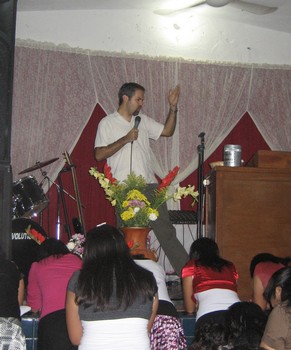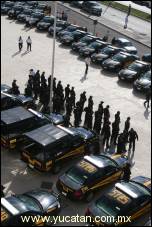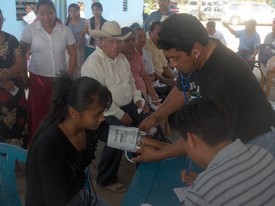Traditional Holy Week celebrated by protestants and catholics in Mexico, and the final week of the Catholic Cuaresma (Lent). This week begins on Domingo de Ramos (Palm Sunday) and culminates on la Pascua (Resurrection Sunday).

We missionaries have a serious job, but it’s important as well that we don’t take ourselves too seriously. Kelly snapped this picture during the prayer time at Monte de Sion Church in Sacalum, Yucatán. As she showed it to me this morning, she asked, “What were you doing?” Well, I thought I would open this up to the opinions of our readers. What do you think it looks like I’m doing? Write a comment and we’ll highlight the most creative interpretation.
Tags: Photo Interpretation
Even after a year and a half here in Mérida, God still finds ways of stretching us. In January, while chatting with pastors before a sectional meeting, our president asked if I played an instrument. I responded that every now and again I played the guitar, while I had considerable experience on the drums. He followed up that question with a request that I lead worship that meeting. Now, I had lead worship in the past, but always in English. (I think the number of choruses that I know on the guitar in Spanish could be counted on one hand.) Therefore, I did what any self-respecting perfectionist would–I put him off, until the next month.
I used that time to gather the some more choruses, practice, and pray. (It’s amazing how the weeks fly when you’re anticipating something like this.) Of course, I second guessed my decision. I almost breathed a sigh of relief when I thought that perhaps the meeting had been canceled for the month, but, regardless of my doubts, the event came. The end result this last Monday certainly wasn’t perfect, but it was a beginning. I was able to sing (staying on key for the majority of the service), play the guitar, and I actually felt that I had led others in worship.
When I began my Spanish classes, I looked forward to the day when I would be able to do this very thing, but for one reason or another, I had put it off. Not enough time, other responsibilities more pressing, the list could go on. Isn’t it great that God doesn’t forget those dreams? In fact, I’ve found He sometimes uses others to push us into realizing them.

“Mérida is a tranquil place.” It’s a place where “no pasa nada (nothing happens),” the residents enjoy saying, but this headline from today’s edition of the Diario de Yucatán, one of the major newspapers of the city, seems to suggest that things may be changing.
No, we are not under military alert, nor have we hired armed guards to follow us around the city. And yes, children still do play in the park down the street, and many enjoy evening strolls along the avenues. But what many once thought was impossible here is now becoming somewhat routine.
Let me give you a run-down of the events.
- January 13th: Police officers and suspects trade fire in the Gran Plaza, a popular shopping center. Officers would later confiscate an AK-47 rifle from those charged in the shootout.
- January 14th: A homicide, thought at first to be an assassination attempt, puts the city on edge. Later investigation makes the husband the principal suspect.
- February 1st: A bomb explodes near the home of the the Secretary’s of Police home in Monte Albán (one neighborhood north of the site of our previous house).
- February 2nd: Citizens of Mérida take to the streets to denounce the escalating crime in a “March for Peace.”
- February 3rd: Meridians receive a report of the assassination of one officer and the wounding of three others in the west of Mérida.
- February 3rd: Ivonne Ortega, governor of the state of Yucatán declares that the the assassination was the result of new measures to “step on the toes” of criminals in Mérida and was an unrelated incident in the new wave of violence.
- February 4th: In what some are saying was a violent reaction to the words of the governor, a resident of Progresso, apparently involved in the drug trade, is found decapitated in a house in Garcia Ginerés (our dentist has his office in this neighborhood.)
Again, I’m not writing this post to alarm you, only to show you the current state of events here in Mérida and ask you to pray. Sure, we’d like to see Mérida return to the sleepy city that it once was, but we would also like to see this wake up call to the police become a wake up call to non-believers and Christians alike.
This world that we live in is broken, and increased security can’t fix it. Only the message of forgiveness of Jesus and a restored relationship with God can, and only a unified, mobilized church, reaching out to it’s community can bring this message.
Pray for peace, but pray for the lasting peace that only salvation can bring.
Photos are from www.yucatan.com.mx. You may also read the special section detailing these events in Spanish.
Tags: Mérida, Organized crime, Peace

I was reading the blogs of some other missionaries, specifically an interesting series of posts on “God’s call to the fools,” when I came across a little tool that measures the level of education that it takes to read and understand a certain website. Some that I tried required an elementary level education, others a high school education and so on. Imagine my surprise however, when I found what it took to read and understand disciplemexico.org. That’s right, the blog readability test said that it takes a genius to understand the things that I say.
This leads me to two conclusions:
- I have a very intelligent reader base. Congratulations then to those who have subscribed and regularly struggled to understand what this rambling missionary writes.
- Perhaps I need to be a bit more accessible in the future. What do you think? Do you read disciplemexico.org with a dictionary.com window open? Let me know.
Oh, and if you want to check out how your blog rates, head over to the blog readability test and find out for yourself.
Tags: Readability

“Leave if you can!” That is the translated name of Salsipuedes one of the two towns that we visited on our medical relief trip to Tabasco. The village of Salsipuedes is situated on the Grijalva River in the Centla of Tabasco, a wetlands region of the state that’s three hours from the capital, one hour on good roads and two on what many would consider “off-road conditions,” but even more overwhelming than the distance to reach this place was the need that we met when we arrived. Sandy Kazim, the organizer and one of the medical providers of the trip told us that for much of the time she felt as though she was running an ER instead of a medical clinic. Four children in the same home with bronchitis and a woman who had recently miscarried were some of the most difficult cases, but case after case of skin infection and other diseases kept the medical providers working long past sunset, the time that we were told we had to leave for the sake of our personal security. Equally as tragic was the spiritual condition of the site. There were reports of active witchcraft taking place and a general look of hopelessness on the faces of many. “Leave if you can” –the name seemed to fit.
Still, that’s the funny thing about the God that we serve. Of all of the needy places that we could have gone, He sent us to the town of Salsipuedes. I think perhaps it was because, even though others had given up on that “Godforsaken” place, He hadn’t. He sent us there as an extension of His love in a tangible way.
I had the chance to enter into homes with several of the students of the Bible Institute while the medical team treated the sick. And as we passed from house to house, entering into their world, I thought of what Christ did for each one of us. He left His glory to live among us, to experience what we experience and to give us the hope that comes from a relationship with God. We in turn were serving as his representatives, offering the same hope that we now enjoy in a place where hope seemed for many to be a distant memory.
I spoke to many and told them that, although they might not have expected it, God had sent us to them specifically to let them know that He had decided to stay in Salsipuedes and that he was looking for hearts in which he could live. We prayed with many as they wrestled to take those first steps toward a relationship with their Creator.
What will happen is hard to determine. The routine of the life poverty has a grip that is relentless. C.S. Lewis once said it this way:
Indeed, if we consider the unblushing promises of reward and the staggering nature of the rewards promised in the Gospels, it would seem that Our Lord finds our desires, not too strong, but too weak. We are half-hearted creatures, fooling about with drink and sex and ambition when infinite joy is offered us, like an ignorant child who wants to go on making mud pies in a slum because he cannot imagine what is meant by the offer of a holiday at the sea. We are far too easily pleased.
So is the work in Salsipuedes; the population is run down, too tired to hope, too tired to dream of something better, and perhaps easily placated with the counterfeits that false religions or momentary escapes like drugs and alcohol can provide. Still, I believe that something began in the heart of those that we touched on that Friday. They received a taste of the love of God, and I believe that through the persistence of the pastor and the congregation that is serving that town, together with the regenerative power of the Holy Spirit, the very character of that town can change. In fact, I’m looking forward to the day when they invite us to the official name changing ceremony.
Tags: flood, hope, relief, Tabasco, team ministry
Official holiday that commemorates Mexico’s Constitution.
Source:Mexonline.com
An official Mexican holiday that kicks off a five-day celebration of the libido before the Catholic lent. Beginning the weekend before Lent, Carnaval is celebrated exuberantly with parades, floats and dancing in the streets.
Source:Mexonline.com
Religious holiday that is celebrated with processions, dancing, bullfights in certain cities, and the blessing of the seeds and candles.
Source:Mexonline.com
New period of classes begins at “Betel” Bible Institute in Mérida Yucatán




